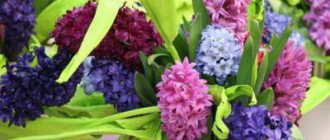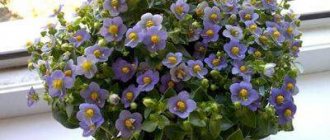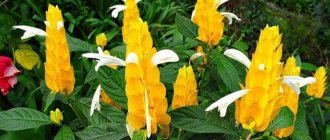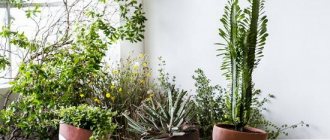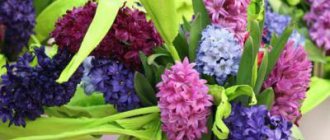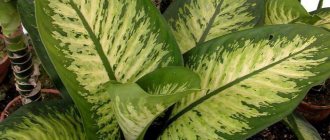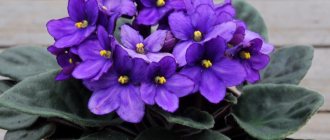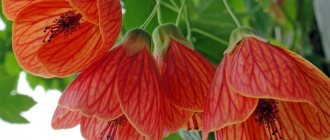List of all plants starting with the letter H (full catalog of names)
On this page, the Living Encyclopedia website is pleased to present to readers an encyclopedia of plants starting with the letter H. Here you will find a complete catalog (list) of all plants on planet Earth whose name begins with the letter H. To go to a detailed description of the plant that interests you starting with the letter H, and also read literature about plants in H - click on the name of the desired plant.
Savory Mountain savory Spike savory Crimean savory Loose-flowered savory Garden savory Blunt savory Tea (plant) Tea tree Tea plants Chayote edible Chalta Chapmenia Chapmenia graceful Chapmenia silky Chastukha Wahlenberg's chastuha Cereal chastuha Lanceolate chastuha vulgaris Chastukha chastuha Chastuha vulgaris Chastuha chastuha Lemon beetle Chemer Itza Chemeritsa Lobelya Chempedak Chereda
Tripartite succession Henderson's succession Virginian bird cherry Maak's bird cherry Cheryomy Maksimovich's bird cherry Common bird cherry Pennsylvanian bird cherry Late wild garlic Cherry cherry Cherimoya Black sapota Blueberry Caucasian blueberry Chernogolovka (plant) Chernogolovka grandiflora Chernogolovka vulgaris Black root Black root Black root Pleasant Black root Nigella (plant) plant) Nigella bukhara Nigella eastern Nigella damascus Nigella glandular Nigella Spanish Nigella acupetallata Nigella arable Nigella field Nigella sativum Nigella allifolia Thistle Curly thistle Drooping thistle Thistles (subtribe) Garlic Garlic Garlic pedunculate Prayer beetle Prayer beetle Lentils Edible thistle Chech Chia (plant) Chiy Chilibuha
Chin Chin Hungarian Chin spring Chin hairy Chin Gmelin Chin pisiform Chin tuberiferous Chin meadow Chin sowing Chin squat Chin pink Chin jointed Chin Japanese Chingil Chistets Alpine Chistets Araxinian Chistets Balanzy Chistets marsh Chistets Byzantine Chistets German Chistets Hissar Chistets Remarkable Chistets Chinese Chistets Komarova Chistets Crete skiy Chistets lavender-leaved Chistets forest Chistets false-flaky Chistets elegant Chistets annual Chistets spinous-cupped Chistets Persian Chistets field Chistets Primorsky Chistets intermediate Chistets straight Chistets downy Chistets heterodentate Chistets Talysh Chistets Terek Chistos three-veined Chistets Turkestan Chistets Turkmen Chistets angustifolia Chistets Chatkal Chistets Bristle Chistets Celandine Asian Celandine Chisto big body Chistoust Chistoust majestic Chistoustovye Chistyak Chistyak spring
Chosenia Mock orange Chubushnik crowned Mock orange Caucasian Mock orange Small-leaved Mock orange Small-leaved Mock orange Shrenk's mock orange Wonderful berries Chulyupa Chumiza Chunia Chupa-chupa Chufa
See information about plants of planet Earth in the catalog alphabetically:
* * * * * * * * * * * * * * * * * * * * * * * * * * * *
Encyclopedia of gardening, floriculture and landscape design
Savory - Herbaceous plants for open ground Savory - Vegetable crops Garden savory - Vegetable crops Annual savory - Vegetable crops Garden savory - Vegetable crops Thyme - Vegetable crops Chagyr tea - Herbaceous plants for open ground Oswego tea - Herbaceous plants for open ground Chayote - Vegetable crops Chamysh - Ornamental trees and shrubs Chastukha - Plants for reservoirs Chastukha Lezelya - Plants for reservoirs Chastukha cereal - Plants for reservoirs Chastukha grass - Plants for reservoirs Chastukha cereal - Plants for reservoirs Chastukha lanceolate - Plants for reservoirs Chastuha vulgaris - Plants for reservoirs Chastukha plantain — Plants for ponds Chebachka — Vegetable crops Chebrik — Vegetable crops Chemysh — Ornamental trees and shrubs Cherery — Herbaceous plants for open ground Feruleleaf succession — Herbaceous plants for open ground Feruleleaf succession — Herbaceous plants for open ground Bird cherry — Ornamental trees and shrubs Bird cherry Maaka — Ornamental trees and shrubs Bird cherry - Ornamental trees and shrubs Bird cherry - Ornamental trees and shrubs Common bird cherry - Ornamental trees and shrubs Late bird cherry - Ornamental trees and shrubs Bird cherry - Ornamental trees and shrubs Ramson - Vegetables Cherem - Herbaceous plants for open ground Ramson - Herbaceous plants for open ground Cherry - Fruit and berry crops Black carrots - Vegetable crops Black Saran - Herbaceous plants for open ground Vegetable blueberries - Vegetable crops Black-eyed Suzanne - Lianas Black-eyed trifoliate hibiscus - Lianas Chernogolovka - Herbaceous plants for open ground Chernogolovka grandiflora - Herbaceous plants for open ground Blackhead - Herbaceous plants for open ground Chernokolen - Ornamental trees and shrubs Blackroot - Herbaceous plants for open ground Black-eyed Suzanne - Indoor plants Chokeberry - Ornamental trees and shrubs Nigella - Herbaceous plants for open ground Nigella Damascus - Herbaceous plants for open ground Nigella sativa - Vegetables Black root - Vegetables Black cumin - Vegetables Devil's bush - Ornamental trees and shrubs Devil's tongue - Houseplants Devil's tree - Ornamental trees and shrubs Garlic - Vegetables Winter garlic - Vegetables Spring garlic - Vegetables crops Chilean jasmine - Indoor plants Chilean myrtle - Indoor plants Chilim - Plants for ponds China - Lianas China - Plants for ponds China - Herbaceous plants for open ground China marsh - Plants for ponds Chin marsh - Herbaceous plants for open ground Spring chin - Herbaceous plants for open ground Chine fragrant - Lianas Chine fragrant - Herbaceous plants for open ground Chingil - Ornamental trees and shrubs Chingil silver - Ornamental trees and shrubs Chistets - Plants for ponds Chistets - Herbaceous plants for open ground Chistets Siebold - Vegetable crops Chistets Byzantine - Herbaceous plants for open ground Chistoust woolly - Herbaceous plants for open ground Chistoust - Herbaceous plants for open ground Chistoust Asian - Herbaceous plants for open ground Chistoust majestic - Herbaceous plants for open ground Chistoust royal - Herbaceous plants for open ground Chistyak - Herbaceous plants for open ground Chistyak spring - Herbaceous plants for open ground Sneeze grass - Herbaceous plants for open ground Chober - Vegetable crops Chobr - Vegetable crops Mock orange - Ornamental trees and shrubs Mock orange Lemoine - Ornamental trees and shrubs Mock orange crown - Ornamental trees and shrubs Mock orange small-leaved - Ornamental trees and shrubs Cast iron plant – Houseplants Chufa – Vegetables
List of plants starting with the letter "A"
Abelia grandiflora (lat. Abelia)
Abelia has about 30 species, but only Abelia grandiflora is grown as an indoor crop. This is a hybrid obtained by crossing Abelia uniflora (Single-flowered Abelia) and Abelia chinensis (Chinese Abelia).
Abutilon (indoor maple) (lat. Abutilon)
This beautiful plant surprises with its abundance of bright, lantern-like flowers and thick, lush greenery. And the gentle disposition and unpretentiousness of care add even more charm to the favorite of many gardeners.
Avraan officinalis (lat. Gratiola officinalis)
The Latin name of the plant of the Norichinaceae family, Avrana officinalis is Gratiola officinalis. It comes from the word “gratia” - grace, gratitude.
Agave (lat. Agave)
Agave is a succulent plant native to Central America. Translated from Greek as “noble”, Mexico, the land of the agave, is named in her honor. All these honors are not accidental - agave is an unpretentious plant, known for its beneficial qualities, including healing ones.
Agapanthus (lat. Agapanthus)
Agapanthus or African lily is a beautiful flowering plant considered a love amulet. Captivated by its lush flowering and ability to attract love, many gardeners successfully keep agapanthus indoors. This plant is unpretentious and well adapted to indoor life.
Ageratum (lat. Ageratum)
Ageratum seeds can be purchased at almost any specialty store. From mid-March they are sown to obtain seedlings. A suitable box is filled with nutrient soil.
Ageratum Houston (Ageratum Mexicana) (lat. Ageratum houstonianum)
The flowering of this plant resembles the delicate blue-lilac or white-pink mink fur. It captivates with its special, discreet beauty. The low shrub is called Ageratum Houston. In their homeland, in the humid and warm tropics of the American continent, there are about 60 species of large and small, perennial and annual, herbaceous plants and subshrubs.
See also:
- Ageratum mexicanis
- Growing ageratum from seeds
Aglaonema brilliant (lat. Aglaonema)
Aglaonema is shade-tolerant; in an apartment, a pot with this plant can be placed even in the darkest place and farthest from windows. Avoid direct contact of aglaonema leaves with sunlight.
Aglaonema changeable (lat. Aglaonema commutatum)
Adiantum (lat. Adiantum)
When shady areas that retain life-giving moisture appear in your garden, it comes to ferns. Such plants at the same time repel and arouse interest.
Adenium (lat. Adenium)
Adenium is one of the rare number of indoor plants that can easily tolerate direct sunlight, so it can be placed on southern windows.
Adenium multiflorum (lat. Adenium multiflorum)
Adenium multiflorum (lat. Adenium multiflorum) belongs to the Kutrov family (lat. Apocynaceae) and belongs to shrubby (tree-like) succulents. Under natural conditions it grows up to one and a half or two meters, and the domestic variety reaches 50-60 centimeters.
Adonis (lat. Adonis)
Ovid in his Metamorphoses retells the legend of how the powerful Venus, angry with Myrrha, the wayward daughter of the ruler of Cyprus, instilled in her a passion for her own father.
Adromiscus (lat. Adromischus)
When caring for Adromiscus, it is important to adhere to some rules for selecting physical growth factors so that this plant feels comfortable and delights with its unusual appearance.
Azalea (Rhododendron) (lat. Azalea, Rhododendron)
Azalea is a unique representative of the heather family, growing up to 50 cm in height and numbering more than 2 thousand garden varieties, of which two are most often cultivated at home.
Climbing Azarina (lat. Asarina scandens, Maurandia scandens)
Climbing Azarina, Asarina scandens or Asarina semperflorens, is native to Mexico. This is the most common species of the Azarina genus, a member of the Plantain family.
Acalypha wilkesiana (lat. Acalypha wilkesiana)
Akalifa bristle-haired, Akalifa rough (lat. Acalypha hispida)
Aquilegia (lat. Aquilegia)
Aquilegia or columbine is a charming garden flower native to the mountainous regions of the Northern Hemisphere. The perennial belongs to the Buttercup family and includes from 60 to 120 species (the exact number has not yet been established).
see also:
- Aquilegia, growing from seeds
Aconite (lat. Aconitum)
Most varieties of Aconite prefer well-lit areas, heated by the sun throughout the day.
Alamanda laxative (lat. Allamanda cathartica)
The Kutrov family (lat. Apocinaceae) includes the genus of the plant Alamanda (lat. Allamanda).
Alyssum (lat. Alyssum)
Alyssum or alyssum is a prominent representative of the Cabbage family, growing in Asia, Europe and North America.
Amazonian alocasia (lat. Alocasia x amazonica)
The genus Alocasia has more than 50 species of plants. Many hybrids have been developed that differ in height and leaf shape. Due to the rather large parameters, not all varieties can be cultivated in a home environment
Large-rooted alocasia (lat. Alocasia macrorrhiza, Alocasia indica)
Aloe tree (Agave) (lat. Aloe arborescens)
Aloe in a flowerpot on a windowsill usually does not grow more than a meter; dwarf varieties and hybrids are grown for decorative purposes.
Aloe Marlota (lat. Aloe marlothii)
Aloe spinous (lat. Aloe aristata)
The appearance of plants is extremely dependent on the illumination of the growing area. With a lack of light, aloe acquires a special, fresh brightness of the leaves, but does not bloom.
Aloe variegata (lat. Aloe variegata)
Variegated aloe (lat. Aloe variegata) belongs to the Xanthorrhoeaceae family (lat. Xanthorrhoeaceae) and is a low-growing succulent no more than 30 cm high. Its leaves are arranged in three rows. The color of the leaves is dark green with white triangular spots.
Aloe squat (lat. Aloe humilis)
Allium (lat. Allium)
Alliums bloom beautifully in well-lit areas. In light partial shade, the brightness of the color of the inflorescences and leaves decreases slightly.
Alpinia (lat. Alpinia)
Sometimes seen in expensive floral arrangements, the flower has a vertical cone of bright red or pink flowers on large stems, and its leaves often release a scent when rubbed.
Alsobia (lat. Alsobia)
Alsobia is a plant that is ideal for a beginning gardener. Even significant violations in the rules of care will not cause her much damage. With good maintenance, it will delight you for many years with its beautiful openwork flowers, spicy aroma and thick green cover.
Alstroemeria (lat. Alstroemeria)
How to grow alstroemeria from seeds so that it pleases you with its future flowering? There are two strategies for growing alstroemeria from seeds: directly sowing them in the ground in April-May or seedlings in February or March.
Amaranth (lat. Amaranthus)
You should know that decorative amaranth has dark seeds, while vegetable and grain amaranth have light ones. Sowing is carried out in the last days of April or early May.
Paniculate amaranth (lat. Amaranthus paniculatus)
Paniculata or scarlet amaranth is an annual that blooms from mid-June until the first frost.
Tricolor amaranth (lat. Amaranthus tricolor)
Tricolor amaranth came to us from the tropics of Asia. This native of the Amaranth family is a pyramidal annual with green, yellow and red leaves ranging from 40 to 150 cm in height.
Tailed amaranth (lat. Amaranthus caudatus)
The tailed amaranth or amaranth, Amaranthus caudatus, is an annual plant native to South America, Asia and Africa.
Amaryllis (lat. Amaryllis)
Native to South Africa, Amaryllis belladonna is a very popular houseplant. Amaryllis is very similar to hippeastrum, but differs from its fellow plant in the absence of leaves during flowering. In addition, amaryllis blooms in autumn, and not in spring, like hippeastrum.
Amorphophallus (lat. Amorphophallus)
Transplantation is carried out in early spring, when sprouts appear on the tubers. For replanting, a mixture suitable for aroid plants is used.
Large tufted pineapple (lat. Ananas comosus)
How to grow pineapple at home, where to start? When preparing a pineapple for growing, you must first select the pineapple fruit and obtain the roots from the top.
Japanese anemone (lat. Anemone japonica)
This type of flower was first discovered at the end of the eighteenth century. It was described as Anemone japonica - Japanese Anemone.
Anigozanthus (lat. Anigozanthos)
There are interesting specimens with two-color flowers: yellow-orange, red-green, lilac-green and red-black. The color depends on the fine hairs covering the flowers and sometimes part of the stem.
Antemis (lat. Anthemis)
Antemis, also known as the navel, belongs to the family Asteraceae and has up to 200 species in its genus.
Antirrinum (lat. Antirrinum)
Antirrinum or snapdragon is a perennial plant belonging to the Norichinaceae family. It comes from the warm countries of the Mediterranean, where about 50 of its species grow. Antirrinum has been known in culture for at least 500 years.
Large Anthurium (lat. Anthurium)
Anthurium leaves are leathery, dark green, can be of different shapes: elongated, heart-shaped, broadly lanceolate, whole or dissected, often beautifully colored.
see also:
- Why doesn't anthurium bloom?
Anthurium Andreanum (lat. Anthurium andreanum)
Anthurium has shallow roots, so the pot should be low and have good drainage. At the same time, the pot should not be too loose, otherwise you may not get flowers.
Climbing Anthurium (lat. Anthurium scandens)
Scherzer's Anthurium (lat. Anthurium scherzerianum)
Aporocactus whip-shaped (lat. Aporocactus)
Aporocactus flagelliformis or rat tail cactus (see photo) is a spectacular cactus native to southwestern Mexico and parts of Central America.
Arabis (lat. Arabis)
You can purchase Arabis seeds at almost any gardening store or center. Sowing of seedlings is carried out either in October or April.
Alpine Arabis (lat. Arabis alpina)
Alpine Arabis is a border and groundcover perennial of the cruciferous family, growing in the lower reaches of the Yenisei and in the Putorana Mountains on rocks, hills and rocky slopes.
Caucasian Arabis (lat. Arabis caucasica)
Caucasian Arabis is a member of the Cruciferous family. This is a herbaceous perennial plant. In the wild, it is found in Mediterranean countries, in the mountainous regions of Asia Minor and Central Asia, in the Caucasus and Crimea.
Araucaria heterophylla (lat. Araucaria heterophylla)
There are a total of 19 plant species belonging to the Araucariaceae family. For the most part these are tall trees with flat needles. Some species are considered decorative; they are bred to decorate streets in the Caucasus and Crimea.
Chilean Araucaria (lat. Araucaria araucana)
Areca (lat. Areka)
The betel palm or areca palm has a total of up to 60 species, distributed in South Asia, the Solomon Islands, the Philippines, and New Guinea.
Areca catehu (Betel palm) (lat. Areka catehu)
The areca catechu palm species grows in the tropical forests of Asia, East Africa, and the Pacific island countries. This palm is sometimes called the betel tree.
Arctotis (lat. Arctotis)
Native to South Africa, arctotis is one of the most prominent members of the large Asteraceae or Asteraceae family.
Armeria (lat. Armeria)
Armerias love the sun very much and are able to withstand drought. They cannot bloom in the shade - they stretch out and lose the brightness of the color of the leaves. These flowers seem to have been specially created by nature to decorate the slopes, constantly illuminated by the bright rays of the sun. Therefore, it is better to plant armeria in the southern part of the garden, in open areas.
Armeria seaside (lat. Armeria maritima)
Armeria seaside is a low (up to 15-20 cm) cushion-shaped plant, which in our latitudes is cultivated as a perennial.
Arunkus (lat. Aruncus)
Volzhanka is propagated mainly by dividing adult bushes. The second method - seed - is used much less frequently. Division is carried out in the spring, before the leaves bloom, or in September.
see also:
- Growing aruncus from seeds
Asklepias (lat. Asclepias)
Asklepias is valuable for its medicinal properties. Its seeds and leaves are widely used in both traditional and folk medicine for the treatment of dermatological diseases (ulcers, eczema, wounds), cardiovascular diseases, and arrhythmia.
Asparagus densely flowered (Asparagus) (lat. Asparagus densiflorus)
Asparagus are perennial rhizomatous vines, herbs or subshrubs with single or small flowers collected in inflorescences.
see also:
- If asparagus leaves turn yellow
Cirrus asparagus (lat. Asparagus plumosus)
Since young asparagus grows very quickly, the roots will eventually become cramped in the pot, so the young plant needs to be replanted annually. Adult asparagus need replanting less often, about once every 2 years.
Meyer's asparagus (lat. Asparagus meyeri)
Meyer's asparagus prefers well-lit places, protected from direct sunlight, so windows with western and eastern exposure are optimal for growing them.
Asparagus Sprenger (lat. Asparagus sprengeri)
Sprenger's asparagus or in Latin Asparagus densiflorus Sprengeri belongs to the asparagus family and is the most popular species of the asparagus genus.
Crescent asparagus (lat. Asparagus falcatus)
Since the homeland of sickle asparagus is the shady forests of Sri Lanka, it does not tolerate direct sunlight falling on its leaves.
Aspidistra (lat. Aspidistra)
There are about 90 species of this plant in nature, but only one is used in indoor floriculture - Aspidistra elatior. It has an unusually long lifespan - up to 100 years.
Hairy asplenium (lat. Asplenium trichomanes)
Nesting asplenium (lat. Asplenium nidus)
Asplenium bulbiferum (lat. Asplenium bulbiferum)
Astilbe (lat. Astilbe)
The speed of plant development is most influenced by air temperature and soil moisture. Tall varieties should be planted at a distance of 0.5 m from each other, low-growing ones - up to 30 cm.
see also:
- Growing astilbe from seeds
Astilbe Arendsii (lat. Astilbe Arendsii)
Astilbe Arends can easily be classified as a deciduous ornamental plant - its dark green foliage is so beautiful, and in some varieties it has reddish-brown foliage.
Chinese astilbe (lat. Astilbe сhinensis)
Astilbe is unpretentious and frost-resistant. A strong, well-developed root system ensures its long life.
Japanese astilbe (lat. Astilbe japonica)
This type of astilbe is distinguished by its small height and compactness compared to other types. The height of the flowering bush is only 30-40 cm.
Astra (lat. Aster)
Preparations for planting aster begin in the fall. First you should choose the location of the future flower garden. The annual plant grows best in open areas, but also tolerates partial shade.
see also: Aster, growing from seeds
Astrantia (lat. Astrantia)
Astrantia is a perennial herbaceous plant from the large celery family, in which there are not so many ornamental species - about 10. It grows in Europe, Asia Minor and the Caucasus, in subalpine meadows, on forest edges and in deciduous forests.
Large astrantia (lat. Astrantia major)
Astrantia large or large is a herbaceous perennial with a stem height of 40 to 90 cm. It has beautiful five-part leaves collected in a basal rosette; the lower ones have long petioles, and the upper ones almost without them.
Countless speckled astrophytum (lat. Astrophytum myriostigma)
When caring for astrophytum, you need to remember that it loves light very much, so you need to place the pot on eastern or southern windowsills. It does not particularly need shading - it is recommended to provide light protection from the sun only in the first weeks of June, so that it gets used to the sun's rays.
Japanese aucuba (lat. Aucuba japonica)
Aphelandra (lat. Aphelandra)
Good lighting is important for the flower, but direct rays of the sun cause burns to the leaf plate. Therefore, the ideal place would be east or west windows. In summer, the aphelandra can be taken out onto the balcony or into the front garden, but protected from drafts and precipitation.
Long-flowered Achimenes (lat. Achimenes longiflora)
On the slightly pubescent straight or branching shoots of Achimenes, serrated shiny leaves covered with small hard hairs are attached.
Acidanthera (lat. Acidanthera)
The name Acidanthera comes from the Greek. acidos - “point” and anthos - “flower” due to the sharp shape of the perianth.
